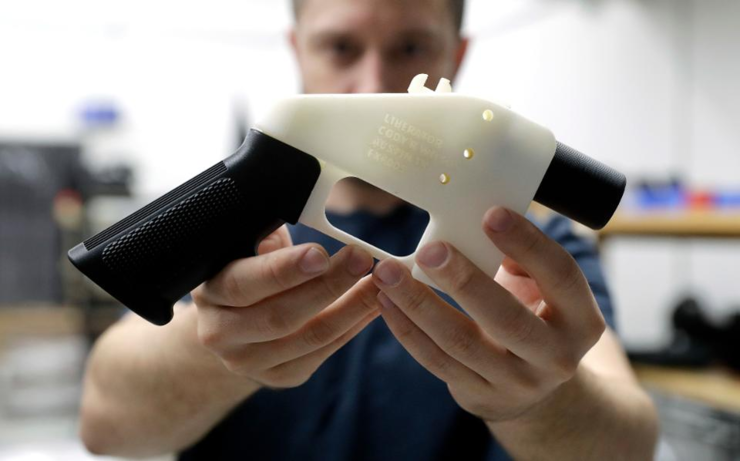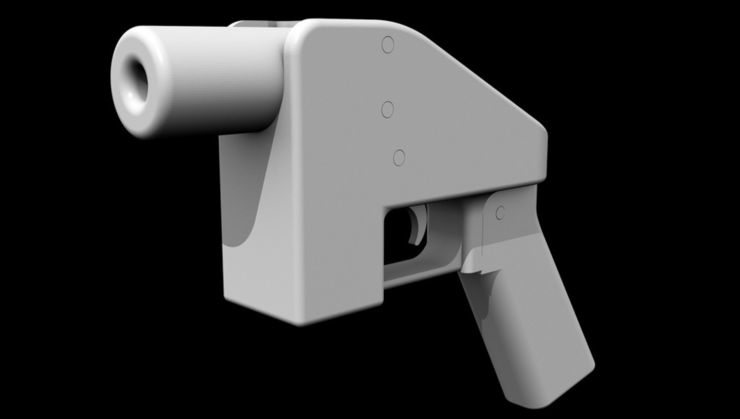In the year 2013, ‘Defense Distributed’, a non-profit organization for open-source gun development and distribution launched a website providing downloadable materials for users to produce their own homemade guns using a 3D printer. Company Director Cody Wilson is credited with introducing the first 3D-printed 9mm semi-automatic rifle to the world.
 |
| ▲ The creator of the 3D printed gun formula, Cody Wilson and his 3D printed gun called the Liberator. (source: Forbes) |
This invention quickly became extremely popular with a huge number of people from different countries with many users downloading this file to make their own weapons. It wasn’t until the site had over 100,000 downloads that the US government, under former President Barack Obama, ordered the deletion of design files, saying the plastic guns violated international arms trading rules. They pointed out that guns made using 3D printers are nearly impossible to trace and are not captured by metal detectors because of the lack of serial numbers and use of plastic material. They also argued that gun manufacturing using 3D printers could pose a serious threat to public safety and national security.
Wilson disagreed and was disappointed with the order to shut down access, so he filed a lawsuit against the federal government. After a five year exhausting trial, the Trump administration agreed to disclose the file and it finally came to an end in June 2018. The court ruled that ‘Code is speech’ and therefore writing code is a form of expression, and banning it contravenes freedom of speech an integral part of the United States Constitution, along with the to freedom to bear arms.. The judgement agreed that his intentions were not illegal, but rather were purely to provide information to people who wanted to make guns at home. They also ruled in his favor because the homemade weapons were unsuitable for military purposes posing no threat to the nation. As a result, Wilson could reload his gun manufacturing data to his Internet site as of August 1, 2018 and once again, people would be able to freely access it.
 |
| ▲ The 3D printed gun formula is made available online again starting August, 2018. (source: The Times of Israel) |
Do homemade plastic guns really pose a threat to people’s safety as the media originally claimed? Opinions are divided on this point. Some argue that they are too dangerous because they cannot be tracked by the government as they do not have serial numbers. For that, the 3D printed guns are called "ghost guns”. If the blueprint is made accessible through the Internet, without any background checks or licensing qualifications, anyone can download the file and make their own guns. Generally, firearm owners must have their guns registered or else they are deemed illegal. However, downloading blueprints requires no extra confirmation of users accessing this new technology. No one can be sure who is creating or possessing this type of weapon. It could be an emotionally unstable person or a potential criminal, which could be dangerous to society.
Plastic guns are also undetectable when passing through metal detectors at a security checkpoints as they are made solely with plastic, apart from the minimal amount of metal in them.
Another reason the US government fears the release of plastic guns is that they could lead to cheap firearm factories and distribution links run by criminals, creating a bigger hole in black market problems. Although the current state of 3D printing does not allow people to create more high-quality and complex firearms, this could change as people go through more trial-and-error runs and gain more production experience. Eventually, this could escalate the technology advances and make 3D printing easier and more affordable, and also provide the skills to create higher-grade weapons.
Others, however, argue that plastic guns may not be as dangerous as expected. Having a 3D printer does cost thousands of dollars, so it might be more convenient for criminals to access a traditional firearm piece. The process, as written by Andy Greenberg a technology journalist of the Wired Magazine, cost 3,064 US Dollars to make an AR-15 with a 3D printer. It is in fact possible, but it is not practical. One plastic gun takes almost 30 hours to print while only being able to fire a few shots before it eventually blows up. Also, owning a 3D printer can be expensive and not everyone can afford it. It remains easier and more affordable to purchase gun parts through legal markets, either online or offline than to purchase a 3D printer and the needed plastic thread to make a gun which cannot work as effectively as a real one.
 |
| ▲ Andy Greenberg, a journalist from technology magazine Wired who tried his hands on making a 3D printed gun. (source: 3ders.org) |
However, even before the issue of 3D gun printing was raised and blamed for creating ‘ghost guns’ because they were untraceable and unregistered, Americans were not exactly refrained from making their own guns with parts they buy on their own. There is no law which makes the domestic gun-production illegal. These guns are also seemingly untraceable and owned without a background check. In order to track down these homemade weapons, authorities would have to go through the gun parts sellers to see who ordered the necessary pieces to make their own. In other words, these guns are technically ghost guns, as much as the 3D printable ones.
In light of recent mass shootings in Florida, the gun ban lobby in America has reached new heights as the nation becomes more sensitive to the concept of private gun ownership. Now, when people are being told that you could easily print your own gun at home, it is understandable that tensions between the pro-gun lobby and anti-gun activists would increase. As this technology is still in the development stages, its long-term threat remains to be seen. It is difficult to judge the 3D printed gun as dangerous while people remain free to possess firearms, either self-made or legally purchased. At this point, it may be too soon to say that 3D guns are the only lawbreakers.
Edward Ng, 김민, Mak Hao Yang dankookherald@gmail.com

![[Campus Magnifier] Let's Surf the Library!](/news/photo/202404/12496_1765_4143.jpg) [Campus Magnifier] Let's Surf the Library!
[Campus Magnifier] Let's Surf the Library!
![[Campus Magnifier] Let's Surf the Library!](/news/thumbnail/202404/12496_1765_4143_v150.jpg)





